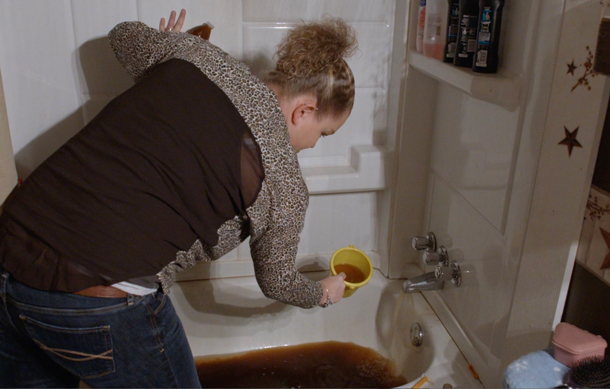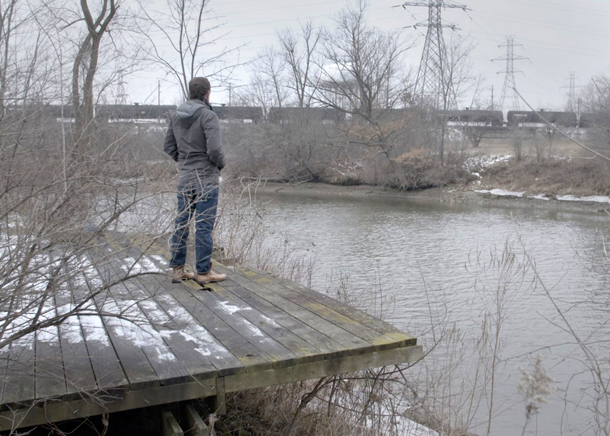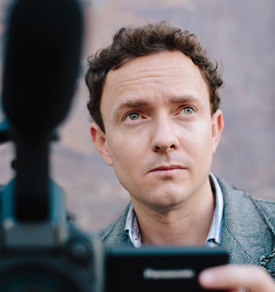Spoiled Water for 300,000: What Lies Upstream
Air Date: Week of April 13, 2018

A West Virginia resident shows the brown water that flows from her tap. (Photo: Hyrax Films)
A 2018 documentary film, What Lies Upstream, investigates a chemical spill in 2014 that left 300,000 West Virginia residents with unsafe drinking water. Filmmaker Cullen Hoback tells host Steve Curwood his work highlights how lax regulations for chemicals and shortcomings of government agencies exposed a sixth of the population of West Virginia to noxious drinking water, and how much of the rest of America is also at risk.
Transcript
CURWOOD: It’s Living on Earth, I’m Steve Curwood. Perhaps the most famous concentration of chemical plants, “Cancer Alley,” lies along the Mississippi between Baton Rouge and New Orleans with more than a hundred petro-chemical refineries and factories. But the rivers near Charleston, West Virginia have a region with a similar name, Chemical Alley, with hundreds of coal mines and dozens of chemical plants.
WEST VIRGINIA RESIDENTS: We used to never have a problem then they put mines up here, mines up here and stuff and then all that sludge and slurry, even into the aquifer it's dripping. And then for years they said it smells funny but it's OK to drink it. Half the people in this trailer park died from cancer.
CURWOOD: Those voices come from a new documentary, What Lies Upstream, that tells the tale of an industrial chemical leak that left 300,000 people with unsafe drinking water. Documentary film producer Cullen Hoback went to Charleston shortly after the water went bad – for a week, he thought. Instead he wound up living there for a year and tells a complicated tale of weak regulation and lax enforcement, and the chemical that fouled the water for a sixth of the people living in West Virginia.
HOBACK: The chemical is called MCHM and it spilled into the Elk River, and for some reason, the Elk River was the only viable source of clean drinking water in the entire region. What made MCHM unique is that MCHM had a very particular quality. You could smell it in the parts per billion, and what that means is that with the tiniest, tiniest fraction of a drop, if you were to put it in a pool, you would still be able to smell it, and that smell was licorice. So, had there been no smell the contamination wouldn't have been uncovered, and people would have just drank the water without knowing.
CURWOOD: Tell me what MCHM is used for.
HOBACK: It's called a coal flocculant, and it's used to help separate the coal. It's part of the coal process. And MCHM was labeled as a non-hazardous chemical, which is important because there are less regulations on it. There's no required inspections of tanks that hold non-hazardous chemicals, there's less rules and controls over how the information around that chemical needs to be reported.
CURWOOD: Wait a second, you're saying it's labeled as a non-hazardous chemical, it’s safe to drink?
HOBACK: This was the question right -- is it non-hazardous? What levels are acceptable? In fact, there are only 72 chemicals that water companies are actually required to test for. So, if these other chemicals get into a water supply, like MCHM, it's legally allowed to be there. Companies aren't required to test for it, and there are over 100,000 chemicals used in commerce that are also labeled non-hazardous which are also able to be in drinking water. This chemical, because it had an odor, people started looking into it, looking into the data behind it and uncovering that, gosh, this chemical is actually a lot more harmful than we thought it was. In fact, it was twice as toxic as the chemical company who made this chemical, Eastman Chemical, had originally reported.
CURWOOD: So, what are the potential health effects or people who were exposed to MCHM?
HOBACK: Yeah, in the very beginning the CDC had reported that you could drink it at one part per million. Anything lower than that would be safe to drink. They later reversed that decision and said, “Well, actually maybe it's not OK for pregnant women”. The reality was is that they were using a tiny amount of science that had been produced by the company. They had no idea really what the effects were, they just thought they did.
There were many people who were having significant reactions to it that weren't in line with the data that had been reported. So, this means that people were having rashes. I talked to one family who there was a little girl whose neck inflated to the size of like a balloon from exposure to this chemical, and people were scared. They had no idea what was causing this originally, and at the same time, the government was coming out and saying, “No, the data says that this chemical couldn't have this effect, certainly not at these levels. You're wrong, you're making this up”.
CURWOOD: Now, at one point you have a scene in your film where you're actually present at a meeting between some industry lobbyists and the head of the West Virginia Department of Environmental Protection. Let's hear a bit of that.
MAN1: Where do you guys see the issue we already have covered?
MAN2: The more hazardous or dangerous it is, then it needs to be included in level one.
MAN3: We don't think that's workable for us.
MAN1: We're already covered under adequate, stringent regulations.
MAN2: That's not going to work. I'm telling you. We'll go back to Bramwell for exemptions to coal mining operations.
MAN3: I think we've done all the damage we can do today.
CURWOOD: I guess the take home here is that industry lobbyists are really helping to actually write the legislation that regulates them.
HOBACK: Yes, so this is a strange turn for me. You know, you hear all the time that this is what happens behind close doors, but you never see it. They were literally writing the law. So, they were crossing things off, they were saying what they would and wouldn't accept, and their word was as good as the law. Nobody had any, any power against them.

At the Flint River during the 2016 crisis, What Lies Upstream director Cullen Hoback looks at the iconic water tower in the distance. (Photo: Hyrax Films)
CURWOOD: Now, you spoke with Mark Edwards, he's at Virginia Tech who helped expose problems with lead in a number of communities, Flint and Washington D.C. Let's listen to a bit of that.
EDWARDS: I have fought a 12-year battle in Washington D.C. exposing government science agency corruption. The Center for Disease Control, the US EPA, the environmental policemen we pay to protect us were actually the environmental criminals. I had to betray some of my best friends, people I went to graduate school with who were working with the EPA and creating fabricated reports.
CURWOOD: Now, why do you think that the agencies tasked with ensuring public health are not taking seriously this issue of safe drinking water?
HOBACK: That is a great question and that is the exact question I asked Dr. Mark Edwards. I repeatedly asked him, “Why, why, why, why would scientists create fake data in ways that harm public health? Why would the CDC and E.P.A. cover things up like this?” It didn't make any sense to me. I thought they were the good guys. He had to very politely and kindly answer my question over and over again. One thing he says is, “Well, why would the Catholic Church do what it did?”
If you incentivize people to do the wrong thing and they can get away with it, they will do that, and what we see in both of these agencies is the incentivization of bad behavior. Don't find bad things. Scientists who try to do the right thing, they get fired, so what happens over time is they just stay in this agency of sort of non-enforcement that is trying to protect its funding, is trying to look good in the eye of the public, and then you have officials who run these agencies that are appointed by politicians who are beholden to corporate interests, to the lobbyists, and so what happens is there is a culture that, like a trickle-down effect from these top officials, and that's what creates this culture of non enforcement.
CURWOOD: We have in our modern industrial society released enormous amounts, quantities and varieties of chemicals into the environment. If one were to spend the day doing an assay for each one of these it would take 100,000 days to figure out what's out there. So, to what extent are regulators caught in this web of really our unrestrained use of chemicals?
HOBACK: You're right. There is this problem of just chemicals are innocent until they're proven guilty, they get released on the market, it takes far longer for a regulatory agency to investigate the chemical and prove that it causes harm than it does for the company to release it, use the chemical commercially, and by the time the EPA figures out, “Gosh, this actually is harmful”, the company can just move on to a different chemical, they can just flip the structure or change it a little bit. The entire system for how chemicals are made, how they're used in commerce, is completely backwards.
CURWOOD: Cullen, you actually took some water samples from the river near some of the various chemical storage facilities and found relatively low levels of concerning chemicals, but you say they end up somewhere that, well, it's rather surprising. Tell me more about that.
HOBACK: So, similar to the situation with MCHM, we thought, well, maybe we're going to find a lot of other chemicals in the river. Well when we got back our results, we were shocked to find that there were no major quantities of anything in the river. So, I talked to Dr. David Lewis, I got in touch with him, an ex-EPA whistleblower who focuses on issues around sewage sludge. And he clued me in and he said, “Well, companies aren't just flushing chemicals down the drain into the river any more, they're flushing chemicals down the drain like you flush chemicals down the toilet”.

Filmmaker Cullen Hoback’s documentaries have been described as non-fiction horror. (Photo: Cullen Hoback)
So, instead of those chemicals going into the river, they were now going into the wastewater treatment plants that were processing them along with sewage sludge, human feces, everything else, and then that was being used to fertilize the lands of America, public lands, and being used all over the country, and so every chemical known to man was ending up in our soil, and then gosh, you know what happens when it rains? That goes right back into the river, and that's what we were finding.
CURWOOD: Please put this story in context for us in terms of drinking water safety in the US as a whole.
HOBACK: I think what you see in the film is what we imagine is a problem, it’s just something that would happen in the Chemical Valley, in fact, a problem that is happening nationally. If you could smell all of the chemicals that are in your drinking water right now like people in West Virginia could smell MCHM, it would be an insane bouquet of scents, you wouldn't be able to drink it.
CURWOOD: What should people do who are listening to us who are maybe concerned about the safety of their own drinking water?
HOBACK: If you use a Brita filter, it'll take out some heavy metals, it'll make your water more safe, but certainly not safe completely because we don't know enough about the chemicals that will still be appearing in that water. There are ways to make things marginally safer, but the reality is that we're going to all be exposed to these chemicals until we start to get the entire regulatory scheme around them under control.
CURWOOD: Cullen Hoback's new film is called "What Lies Upstream." Thanks so much for taking the time with us today.
HOBACK: Love your show. Thanks for having me.
Links
What Lies Upstream first airs on PBS 4.1.6.18- check your local station for listings
Living on Earth wants to hear from you!
Living on Earth
62 Calef Highway, Suite 212
Lee, NH 03861
Telephone: 617-287-4121
E-mail: comments@loe.org
Newsletter [Click here]
Donate to Living on Earth!
Living on Earth is an independent media program and relies entirely on contributions from listeners and institutions supporting public service. Please donate now to preserve an independent environmental voice.
NewsletterLiving on Earth offers a weekly delivery of the show's rundown to your mailbox. Sign up for our newsletter today!
 Sailors For The Sea: Be the change you want to sea.
Sailors For The Sea: Be the change you want to sea.
 The Grantham Foundation for the Protection of the Environment: Committed to protecting and improving the health of the global environment.
The Grantham Foundation for the Protection of the Environment: Committed to protecting and improving the health of the global environment.
 Contribute to Living on Earth and receive, as our gift to you, an archival print of one of Mark Seth Lender's extraordinary wildlife photographs. Follow the link to see Mark's current collection of photographs.
Contribute to Living on Earth and receive, as our gift to you, an archival print of one of Mark Seth Lender's extraordinary wildlife photographs. Follow the link to see Mark's current collection of photographs.
 Buy a signed copy of Mark Seth Lender's book Smeagull the Seagull & support Living on Earth
Buy a signed copy of Mark Seth Lender's book Smeagull the Seagull & support Living on Earth

